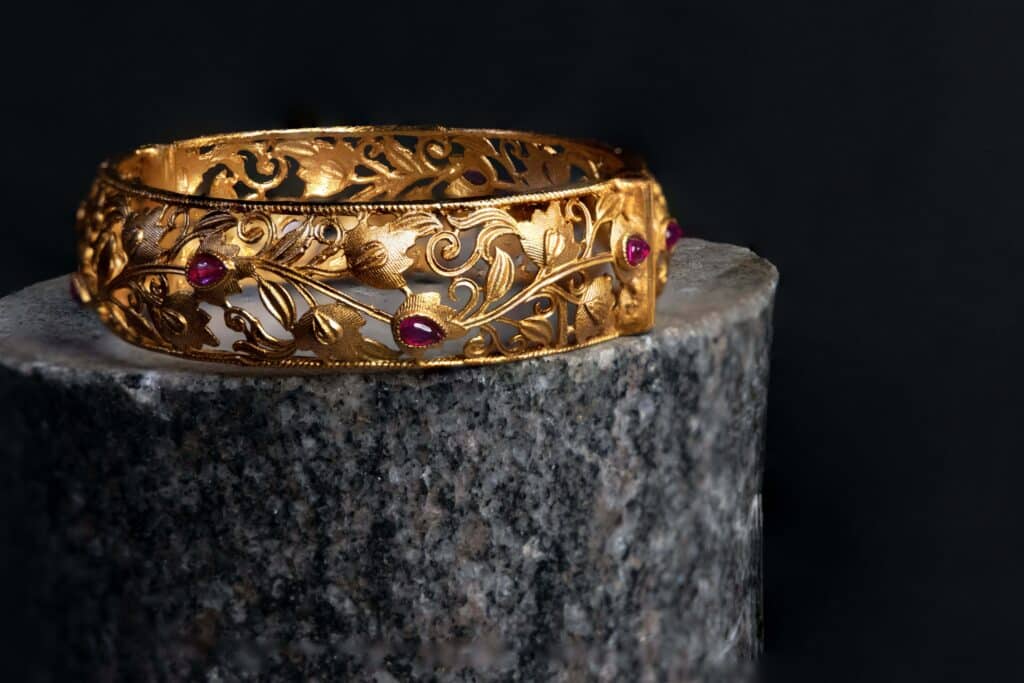
Brass jewelry has long captivated wearers with its unique charm and affordability. However, a common concern among brass jewelry enthusiasts is whether these dazzling pieces are prone to tarnishing. In this article, we delve into the intriguing world of brass jewelry to answer the age-old question: Does brass jewelry tarnish? Join us as we unravel the science behind tarnishing, explore preventive measures, and uncover the beauty of naturally aged brass. Whether you’re a brass jewelry fan or simply curious about this captivating metal, read on to gain valuable insights into preserving the allure of your brass treasures.
Does brass jewelry tarnish?
Yes, brass jewelry can tarnish over time. Tarnishing in brass is primarily caused by exposure to air, moisture, and certain chemicals, which lead to oxidation. However, regular cleaning and proper maintenance can minimize tarnishing and keep your brass jewelry looking beautiful. Some people even appreciate the unique patina that develops on brass over time, considering it a part of the jewelry’s character.
Factors Contributing To Tarnish
Several factors contribute to the tarnishing of brass jewelry:
- Exposure to Air: Brass jewelry tarnishes primarily due to its reaction with the oxygen present in the air. This reaction is known as oxidation. When exposed to oxygen over time, brass forms a layer of tarnish on its surface. This tarnish typically appears as a dull, discolored layer, often with shades of brown or green, and can negatively impact the visual appeal of the jewelry.
- Moisture and Humidity: High humidity levels can accelerate tarnish formation on brass jewelry. This is because air moisture contains oxygen, which can provide the conditions for oxidation to occur more rapidly. In regions with humid climates, brass jewelry may be more susceptible to tarnishing.
- Chemical Exposure: Brass jewelry can tarnish when it comes into contact with various chemicals commonly found in daily life. Perfumes, lotions, cosmetics, and cleaning agents often contain compounds that can react with the metal. The chemicals in these products can cause discoloration or dullness on the surface of the brass.
- Skin Chemistry: The pH levels and composition of an individual’s skin can vary. Some people have more acidic skin, which can react with the brass, leading to tarnishing. This is why some individuals might experience tarnish on their brass jewelry more quickly than others.
- Storage Conditions: How you store your brass jewelry is crucial in preventing tarnish. Storing brass jewelry in a humid or poorly ventilated environment can encourage tarnish formation. Improper storage can exacerbate the effects of air and moisture exposure.
- Handling and Touch: Frequently handling brass jewelry can transfer oils and moisture from your skin onto the metal’s surface. These substances can act as catalysts for tarnish formation, especially when combined with exposure to air and moisture.
Why Brass Is Prone To Tarnish
Brass is prone to tarnish primarily due to its composition and the chemical reactions when exposed to certain environmental factors. Here’s why brass is susceptible to tarnish:
Copper Content: Brass is an alloy made primarily of copper (usually around 60-70%) and zinc (30-40%). Copper, in its natural state, is highly susceptible to oxidation. When exposed to oxygen in the air, copper undergoes a chemical reaction, forming copper oxide on its surface. This copper oxide appears dull and discolored, giving brass jewelry its tarnished appearance.
Oxidation: Tarnishing is an oxidation process. When brass is exposed to oxygen, a chemical reaction occurs where oxygen molecules combine with the copper atoms on the surface of the metal. This forms copper oxide, which is the tarnish. The reaction is accelerated when the brass is exposed to moist or humid conditions, as water vapor contains oxygen.
Chemical Reactions: Brass jewelry can come into contact with various chemicals in everyday life, such as perfumes, lotions, cosmetics, and cleaning agents. Some of these chemicals contain compounds that can react with the metal. The reactions with these chemicals can contribute to tarnish formation on the brass’s surface, resulting in discoloration and dullness.
Acidity: The acidity of an individual’s skin can also affect how quickly brass jewelry tarnishes. Skin with a higher acidity level can accelerate the oxidation process, leading to tarnish formation more rapidly when the metal comes into contact with the skin.
Handling and Touch: Frequent handling of brass jewelry can transfer oils and moisture from the skin onto the metal’s surface. These substances can act as catalysts for tarnish formation, especially when combined with exposure to air and moisture.
While brass jewelry is prone to tarnish, understanding the reasons behind it and taking preventive measures can help you maintain its beauty and prolong its shine. These measures include proper storage, avoiding contact with chemicals, and minimizing exposure to humidity and excessive handling.
What Are Some Effective Methods For Preventing Tarnish On Brass Jewelry
Preventing tarnish on brass jewelry is essential to maintain its luster and visual appeal over time. Here are some effective preventive measures:
- Proper Storage: Storing your brass jewelry in airtight containers or ziplock bags is a highly effective way to prevent tarnish. These containers create a barrier between the jewelry and the air, reducing the exposure of the brass to oxygen, a critical factor in tarnish formation. Ensure the storage container is completely dry before placing your jewelry inside, as moisture can accelerate tarnishing.
- Anti-Tarnish Strips or Pouches: Anti-tarnish strips or pouches are small, convenient tools designed to absorb moisture and inhibit tarnish formation. Place them alongside your brass jewelry in storage containers to maintain a controlled environment that minimizes the risk of tarnish. These products are readily available and practical additions to your jewelry care routine.
- Individual Wrapping: When storing multiple pieces of brass jewelry together, it’s wise to wrap each item in a soft, non-abrasive cloth or a dedicated jewelry pouch. This precaution helps prevent scratches and minimizes contact between the jewelry pieces, reducing the chances of tarnishing. Additionally, it simplifies selecting and retrieving specific items from your collection.
- Avoid Moisture and Humidity: Moisture and humidity can significantly accelerate tarnishing. Store your brass jewelry in a dry, calm, and well-ventilated area to shield it from these elements. If you live in a region with high humidity, consider investing in a dehumidifier for your storage space to maintain ideal conditions for your jewelry.
- Remove Before Activities: Certain activities can expose your brass jewelry to moisture, chemicals, and physical abrasion, contributing to tarnish. Therefore, removing your brass jewelry before engaging in activities like swimming, showering, applying lotions or perfumes, or cleaning with household chemicals is essential. This simple practice can significantly extend the life and shine of your jewelry.
- Regular Cleaning: Periodically cleaning your brass jewelry is essential to remove any tarnish that may have formed. Use mild, non-abrasive jewelry cleaners designed explicitly for brass or a mixture of warm water and gentle dish soap. After cleaning, dry the jewelry thoroughly with a soft, lint-free cloth to prevent moisture from lingering, as it can lead to tarnish.
- Protective Coatings: Applying a protective coating to your brass jewelry can create a physical barrier between the metal and the environment, reducing the risk of tarnish. Clear lacquer, wax, or oil-based coatings are commonly used. Follow the manufacturer’s instructions when applying these coatings and reapply them as needed to maintain their protective properties.
- Wear Carefully: Be mindful of how and when you wear brass jewelry. Avoid wearing it when it may come into contact with hard surfaces or objects that can cause scratches or dents. Removing your jewelry before engaging in physically demanding activities or tasks can help preserve its appearance.
- Clean Before Storage: Before storing your brass jewelry, ensure it is clean and scorched. Any residual oils, sweat, or moisture left on the jewelry can contribute to tarnish formation during storage. Cleaning and drying the jewelry thoroughly before storing it will help maintain its shine and prevent tarnishing while in storage.
- Rotate Usage: If you have a collection of brass jewelry, consider rotating your pieces regularly. This practice ensures that each item gets some wear and prevents one piece from sitting unused for an extended period. Regular wear can help keep the jewelry’s surface polished and reduce the risk of tarnish formation.
By incorporating these preventive measures into your brass jewelry care routine, you can significantly reduce the likelihood of tarnish formation and enjoy your jewelry’s beauty for years.
Effective Methods For Preventing Tarnish On Brass Jewelry
here’s a detailed explanation of the methods for removing tarnish from brass jewelry:
Homemade Remedies:
Homemade remedies for tarnish removal are cost-effective and readily available. One standard method involves creating a paste by mixing baking soda and lemon juice. Apply this paste to the tarnished areas of your brass jewelry using a soft cloth or a toothbrush with soft bristles. This mixture effectively removes tarnish through a mild abrasive action and the acidic properties of lemon juice. Afterward, rinse the jewelry thoroughly with water and ensure it’s scorched to prevent further tarnishing. Another homemade option is to make a paste with white vinegar and salt, which works similarly to the baking soda and lemon juice method.
Commercial Brass Cleaners:
Commercial brass cleaners, such as sprays, polishes, and dips, come in various forms and are specifically designed to remove tarnish from brass. These products often contain ingredients that dissolve tarnish and restore the shine to your jewelry. When using commercial cleaners, read the product labels carefully to select one that suits your jewelry and follow the manufacturer’s instructions for safe and effective use. Taking safety precautions when using these products, wearing gloves, and working in a well-ventilated area is essential. After cleaning, rinse your jewelry thoroughly to remove any residue left by the cleaner.
Professional Cleaning Services:
For valuable or intricately designed brass jewelry, seeking the expertise of a professional jeweler or metalworker is an excellent choice. Professionals have the knowledge and specialized equipment to safely remove tarnish without damaging your jewelry. When you visit a professional, they can also advise on the maintenance and care of your brass pieces, helping you keep them looking their best over time.
These tarnish-removal methods offer a range of options to cater to various preferences and situations. The choice of method may depend on factors like the severity of tarnish, the type of jewelry, and personal convenience. Regardless of the method you choose, always prioritize safety by following instructions carefully to ensure the longevity and beauty of your brass jewelry.
Final Word
In conclusion, brass jewelry may tarnish over time due to oxidation, but its beauty can be preserved with proper care and understanding. Whether you embrace the evolving patina or prefer a pristine shine, knowing how to prevent and address tarnish will ensure your brass jewelry remains a cherished and timeless accessory in your collection.
FAQ’s
Q. Why does brass jewelry tarnish?
Brass jewelry tarnishes primarily due to its composition, which includes copper and zinc. When exposed to oxygen in the air, copper in the brass undergoes oxidation, forming a tarnished layer of copper oxide. Other factors like moisture, humidity, and chemical exposure can also accelerate tarnishing.
Q. Can tarnished brass jewelry be restored to its original shine?
Yes, tarnished brass jewelry can often be restored to its original shine. There are various methods for removing tarnish, including homemade remedies, commercial brass cleaners, and professional cleaning services. The choice of method depends on the severity of tarnish and personal preferences.
Q. How can I prevent tarnish from forming on my brass jewelry?
Preventing tarnish involves proper storage, regular cleaning, and protective coatings. Storing your jewelry in airtight containers or pouches, avoiding exposure to moisture and chemicals, and applying clear lacquer or wax coatings can all help prevent tarnish.








